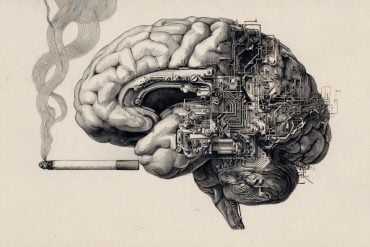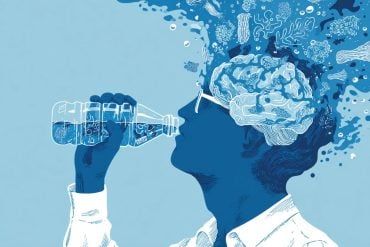Summary: Substance use disorders (SUDs) accelerate biological aging in the brain through substance-specific molecular mechanisms. Using brain-specific epigenetic clocks, researchers found that alcohol, opioids, and stimulants each trigger unique patterns of neurodegeneration, particularly in the decision-making centers of the brain.
Despite their differences, these substances share common aging drivers, including oxidative stress, neuroinflammation, and mitochondrial dysfunction. The findings suggest that addiction should be viewed not only as a behavioral issue but as a form of premature brain aging, with critical implications for treatment and public health.
Key Facts:
- Substance-Specific Aging: Alcohol, opioids, and stimulants each age the brain through unique biological mechanisms.
- Shared Damage Pathways: Mitochondrial dysfunction, oxidative stress, and neuroinflammation are common across all SUDs.
- Reframing Addiction: SUDs may represent an accelerant of neurodegeneration, altering how relapse and treatment are understood.
Source: Genomic Press
In a comprehensive Genomic Press Interview, researchers from UTHealth Houston have uncovered crucial evidence that substance use disorders (SUDs) accelerate biological aging in the brain through distinct molecular mechanisms.
The groundbreaking study, published today in Genomic Psychiatry, examines how different substances, such as alcohol, opioids, and stimulants, affect the brain’s aging process at the molecular level, potentially explaining why individuals with SUDs often experience early-onset age-related diseases.

Accompanying the research article is an insightful editorial titled “The forgotten clockwork of the brain: Untangling accelerated aging in substance use disorders,” authored by Dr. Julio Licinio, Editor-in-Chief of Genomic Psychiatry.
Revolutionary Study Design and Methodology
The research team, led by Drs. Bruno Kluwe-Schiavon, Gabriel Fries, and Consuelo Walss-Bass, analyzed brain tissue from 58 donors with SUDs to assess differential aging patterns using specialized epigenetic clocks designed specifically for brain tissues.
Unlike previous studies that relied on more general epigenetic aging markers, this investigation employed brain-specific tools (DNAmClockCortical, CerebralCortexClockcommon, and PCBrainAge) to provide a more accurate assessment of neural aging.
“Our study is the first to investigate brain accelerated aging in substance use disorders using epigenetic clocks specifically designed for brain tissues,” explains Dr. Kluwe-Schiavon.
“This approach allowed us to capture unique aspects of the aging process in the brain that might have been missed with more general methods.”
The researchers focused on the dorsolateral prefrontal cortex, a brain region central to decision-making and executive control that is particularly vulnerable to addiction.
By examining postmortem brain tissue and conducting sophisticated gene expression analyses, the team identified specific molecular signatures associated with accelerated aging in different SUDs.
Substance-Specific Aging Mechanisms Revealed
One of the study’s most significant findings was that different substances appear to accelerate brain aging through distinct biological pathways. In alcohol use disorder, researchers found altered expression of genes involved in protein phosphorylation, signal transduction, and glutamatergic synapse function.
For opioid use disorder, transcriptional regulation, neurodevelopment, and immune-inflammatory processes emerged as key drivers of accelerated aging. Stimulant use disorder showed distinct patterns related to oxidative stress, hypoxia responses, and cell adhesion pathways.
Dr. Walss-Bass emphasizes the importance of these findings: “We’ve discovered that accelerated aging in substance use disorders is not a uniform process. Each substance appears to hijack the brain’s natural aging rhythm through unique molecular mechanisms, though some pathways are shared across different substance types.”
Mitochondrial Dysfunction: A Common Thread
Despite the differences between substances, the research identified some common biological mechanisms across all SUDs. Neuroinflammation, oxidative stress, and mitochondrial dysfunction appeared to play crucial roles in accelerated aging regardless of the specific substance used.
“Our integrative analysis suggests that mitochondrial function, the powerhouse of the cell, is central to maintaining cellular energy homeostasis and regulating oxidative stress responses,” notes Dr. Gabriel Fries, co-corresponding author of the study.
“When substance use disrupts these processes, it can accelerate the biological aging of neural tissue.”
Implications for Public Health and Treatment
The findings have profound implications for public health, addiction medicine, and treatment approaches. If substance use induces premature biological aging, it should be viewed not merely as a behavioral choice but as an accelerant of neurodegeneration.
“What we call relapse may sometimes be the cognitive exhaustion of a prematurely aged cortex,” suggests Dr. Kluwe-Schiavon.
“This perspective shifts how we think about addiction treatment and recovery.”
The research opens the door to a new field that the authors describe as “the psychiatry of aging in young people.”
It calls for longitudinal investigations that follow individuals through abstinence, relapse, remission, and decay, as well as integrative biomarker panels that combine methylation, gene expression, and neuroimaging.
Editorial Perspective
In his accompanying editorial, Dr. Julio Licinio offers a thought-provoking perspective on the study’s implications. “This is not just a question of whether drugs kill. We already know they do.
“The deeper question, provocative and new, thanks to this anatomically grounded work, is whether drugs age the brain,” writes Dr. Licinio.
“He emphasizes that the aging effects observed in substance use disorders are “neither cosmetic nor metaphorical. It is cellular. It is molecular. And it is coded into the methylated terrain of the genome.”
Dr. Licinio notes that the findings have implications far beyond the laboratory, reaching into public health, addiction medicine, criminal justice, and education policy.
“If substance use induces premature biological aging, then we must treat it not merely as a moral lapse or behavioral choice, but as an accelerant of neurodegeneration,” he argues.
Future Research Directions
While the study provides valuable insights, the researchers acknowledge several limitations, including the relatively small sample size and cross-sectional design, which limits causal interpretations.
They call for future research with larger cohorts and longitudinal designs to confirm their findings and further elucidate the mechanisms of accelerated aging in different SUDs.
An intriguing question emerging from this research is why some brains deteriorate faster than others under similar pharmacological conditions. Could there be predisposing genomic signatures, either genetic susceptibilities or epigenetic scars left by early-life adversity, that make some individuals biologically more vulnerable to substance-induced aging?
“If one is to be optimistic, and one must be, even in the face of molecular entropy, then perhaps these findings mark the beginning of a therapeutic redirection,” Dr. Licinio suggests in his editorial.
“Anti-aging interventions, long the obsession of cosmetic medicine and Silicon Valley biohackers, might soon find their most ethically urgent application in addiction psychiatry.”
About this addiction and brain aging research news
Author: Ma-Li Wong
Source: Genomic Press
Contact: Ma-Li Wong – Genomic Press
Image: The image is credited to Neuroscience News
Original Research: Open access.
“Deciphering the molecular basis of accelerated biological aging in substance use disorder: Integrative transcriptomic analysis” by Bruno Kluwe-Schiavon et al. Genomic Psychiatry
Abstract
Deciphering the molecular basis of accelerated biological aging in substance use disorder: Integrative transcriptomic analysis
Substance use disorders (SUDs) contribute to early-onset age-related diseases and represent a major global health burden. Accelerated biological aging (AA) has been proposed as a key factor behind SUD-related morbidity and mortality.
This study aimed to elucidate the molecular basis of AA in SUD by analyzing transcriptomic profiles in postmortem dorsolateral prefrontal cortex tissue from individuals with SUD, including alcohol (AUD), opioid (OUD), and stimulant use disorders (StUD).
We examined brain tissue from 58 donors to assess differential aging patterns and AA across SUD using epigenetic clocks specifically designed for brain tissues (DNAmClockCortical, CerebralCortexClockcommon, and PCBrainAge).
Samples were then stratified into those with and without AA to perform differential expression analyses across groups and to identify biological pathways potentially related to AA. Analyses identified multiple differentially expressed genes linked to AA, revealing unique and overlapping biological pathways within SUD subtypes.
Further, our analysis highlighted shared aging mechanisms across SUD subtypes, particularly mitochondrial signaling and metabolic processes. While insightful, these subtype-specific findings remain exploratory due to limited statistical power.
Most biological pathways underlying AA in SUD appear to be subtype-specific, with distinct molecular signatures influenced by substance type. Given the cross-sectional design, causal interpretations are limited.
Further research may support targeted interventions for aging-related risks in SUD populations.






